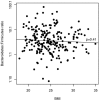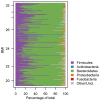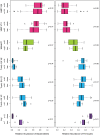A taxonomic signature of obesity in the microbiome? Getting to the guts of the matter
- PMID: 24416266
- PMCID: PMC3885756
- DOI: 10.1371/journal.pone.0084689
A taxonomic signature of obesity in the microbiome? Getting to the guts of the matter
Abstract
Obesity is an important and intractable public health problem. In addition to the well-known risk factors of behavior, diet, and genetics, gut microbial communities were recently identified as another possible source of risk and a potential therapeutic target. However, human and animal-model studies have yielded conflicting results about the precise nature of associations between microbiome composition and obesity. In this paper, we use publicly available data from the Human Microbiome Project (HMP) and MetaHIT, both surveys of healthy adults that include obese individuals, plus two smaller studies that specifically examined lean versus obese adults. We find that inter-study variability in the taxonomic composition of stool microbiomes far exceeds differences between lean and obese individuals within studies. Our analyses further reveal a high degree of variability in stool microbiome composition and diversity across individuals. While we confirm the previously published small, but statistically significant, differences in phylum-level taxonomic composition between lean and obese individuals in several cohorts, we find no association between BMI and taxonomic composition of stool microbiomes in the larger HMP and MetaHIT datasets. We explore a range of different statistical techniques and show that this result is robust to the choice of methodology. Differences between studies are likely due to a combination of technical and clinical factors. We conclude that there is no simple taxonomic signature of obesity in the microbiota of the human gut.
Conflict of interest statement
Figures



 -test.
-test.Similar articles
-
A core gut microbiome in obese and lean twins.Nature. 2009 Jan 22;457(7228):480-4. doi: 10.1038/nature07540. Epub 2008 Nov 30. Nature. 2009. PMID: 19043404 Free PMC article.
-
Gut microbiome diversity influenced more by the Westernized dietary regime than the body mass index as assessed using effect size statistic.Microbiologyopen. 2017 Aug;6(4):e00476. doi: 10.1002/mbo3.476. Epub 2017 Jul 4. Microbiologyopen. 2017. PMID: 28677210 Free PMC article.
-
Gut microbiome composition in lean patients with NASH is associated with liver damage independent of caloric intake: A prospective pilot study.Nutr Metab Cardiovasc Dis. 2018 Apr;28(4):369-384. doi: 10.1016/j.numecd.2017.10.014. Epub 2017 Oct 26. Nutr Metab Cardiovasc Dis. 2018. PMID: 29482963
-
The guts of obesity: progress and challenges in linking gut microbes to obesity.Discov Med. 2015 Feb;19(103):81-8. Discov Med. 2015. PMID: 25725222 Review.
-
The gut microbiota and its relationship to diet and obesity: new insights.Gut Microbes. 2012 May-Jun;3(3):186-202. doi: 10.4161/gmic.20168. Epub 2012 May 1. Gut Microbes. 2012. PMID: 22572830 Free PMC article. Review.
Cited by
-
Looking for a Signal in the Noise: Revisiting Obesity and the Microbiome.mBio. 2016 Aug 23;7(4):e01018-16. doi: 10.1128/mBio.01018-16. mBio. 2016. PMID: 27555308 Free PMC article.
-
Heritable components of the human fecal microbiome are associated with visceral fat.Genome Biol. 2016 Sep 26;17(1):189. doi: 10.1186/s13059-016-1052-7. Genome Biol. 2016. PMID: 27666579 Free PMC article.
-
Meta-Analysis Reveals Reproducible Gut Microbiome Alterations in Response to a High-Fat Diet.Cell Host Microbe. 2019 Aug 14;26(2):265-272.e4. doi: 10.1016/j.chom.2019.06.013. Epub 2019 Jul 16. Cell Host Microbe. 2019. PMID: 31324413 Free PMC article.
-
Papio spp. Colon microbiome and its link to obesity in pregnancy.J Med Primatol. 2018 Dec;47(6):393-401. doi: 10.1111/jmp.12366. Epub 2018 Jul 24. J Med Primatol. 2018. PMID: 30039863 Free PMC article.
-
Lifestyle and Metabolic Syndrome: Contribution of the Endocannabinoidome.Nutrients. 2019 Aug 20;11(8):1956. doi: 10.3390/nu11081956. Nutrients. 2019. PMID: 31434293 Free PMC article. Review.
References
-
- Lim SS, Vos T, Flaxman AD, Danaei G, Shibuya K, et al. (2013) A comparative risk assessment of burden of disease and injury attributable to 67 risk factors and risk factor clusters in 21 regions, 1990–2010: a systematic analysis for the global burden of disease study 2010. The Lancet 380: 2224–2260. - PMC - PubMed
-
- Douketis J, Macie C, Thabane L, Williamson D (2005) Systematic review of long-term weight loss studies in obese adults: clinical significance and applicability to clinical practice. International Journal of Obesity 29: 1153–1167. - PubMed
-
- Turnbaugh PJ, Ley RE, Mahowald MA, Magrini V, Mardis ER, et al. (2006) An obesity-associated gut microbiome with increased capacity for energy harvest. Nature 444: 1027–131. - PubMed
Publication types
MeSH terms
Grants and funding
LinkOut - more resources
Full Text Sources
Other Literature Sources
Medical

